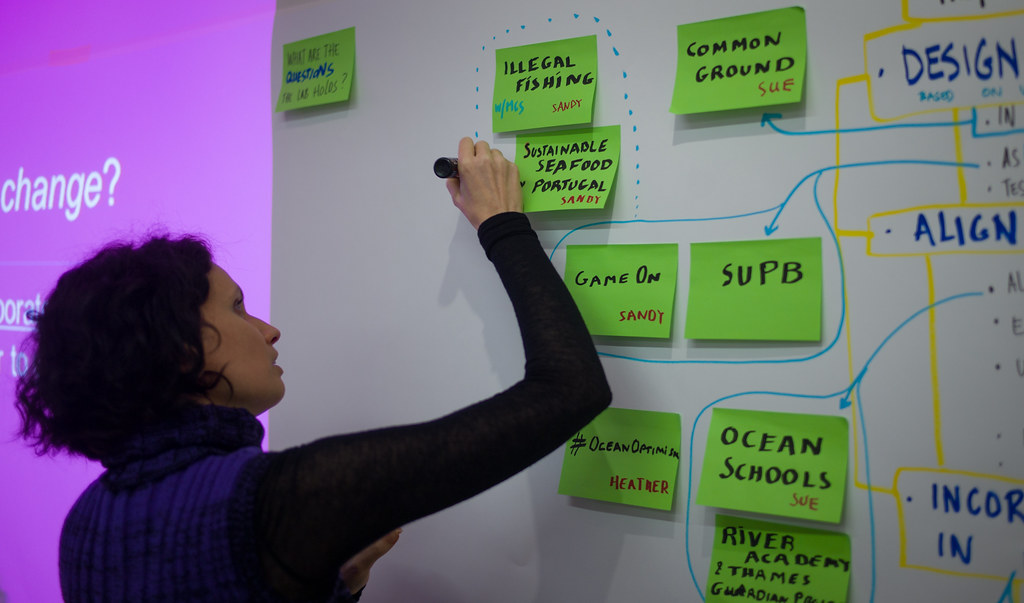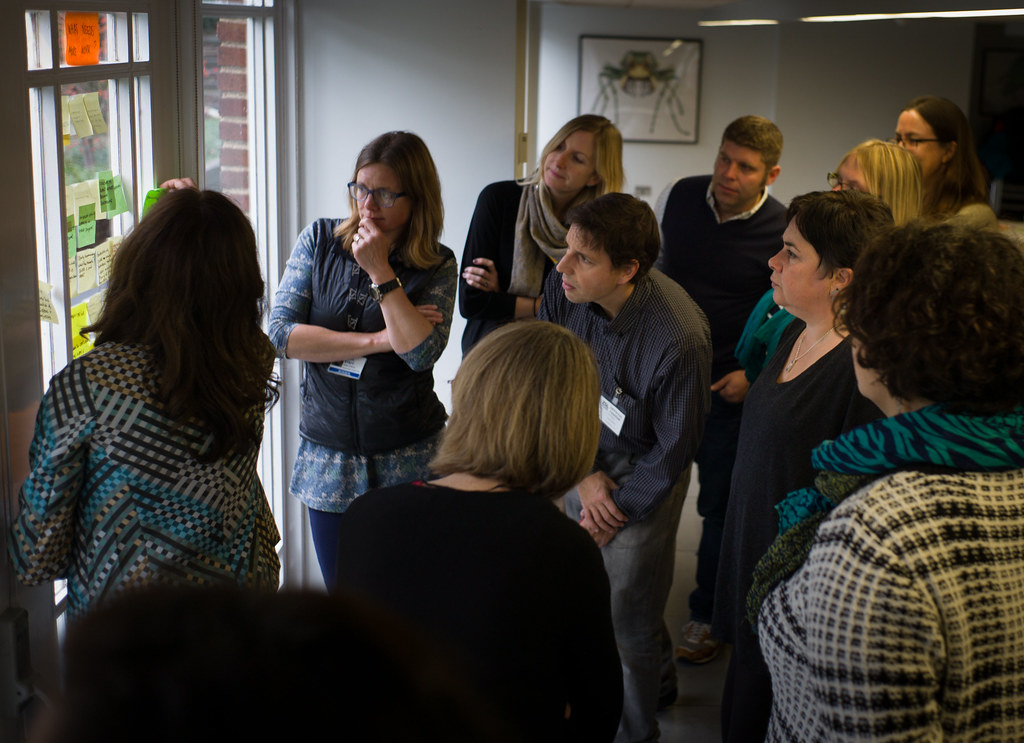This is an old revision of the document!
The Lab Approach
An essay on the Marine CoLABoration process by FOAM
NOTE: This is the first part of the essay, focusing on the lab approach in general. The second part, to be published in March 2017 will focus on Marine CoLABoration as a specific case study in using the lab approach.
Part I
Improving the health of the ocean is one of the urgent, complex problems of our time. If it were simple to solve it (e.g. with time, effort or money) it would almost certainly have been. The threats to the marine environment - and by extension to human wellbeing - are too entangled for neat single-issue solutions. Anything less than systemic change will be insufficient.This is no reason to become discouraged or to give up. Rather the opposite. It is a motivation to approach the issues from multiple points of view, to imagine, to experiment and to learn from failure; to appreciate what works and to understand how things could be systemically improved. This is the essence of the “lab approach”: enabling accelerated systemic innovation at reduced risk.
Marine CoLABoration is an example of using the lab approach to improve flows of knowledge in the environmental sector, thereby developing the capacity needed to improve the health of the ocean. It was initiated by the CGF UK “to explore how human values and the value of the ocean are reflected in individual and collective decision-making and can be utilised to increase ocean protection” (from the Marine CoLABoration mission statement. FoAM (Maja Kuzmanovic, Vali Lalioti and Nik Gaffney) designed, facilitated and documented the lab process during its incubation phase. This article reflects on the lab approach in general and on Marine CoLABoration as a specific case study.

What is a lab?
The Lab evokes the smell of ozone, the excitement of experiment, the chaotically direct activity of ants, the energy of shared purpose and promise of adventures into the unknown. (…) We see labs as places where structured research can coexist with unstructured tinkering and exploration. Open enough to encourage serendipity, while retaining the rigor necessary to access, develop and spread knowledge.“ - From The Future of the Lab
Contemporary labs have many guises. The labs we talk about here are known as change labs, systems labs, civic labs, social or cultural innovation labs and so forth. The key characteristic of such labs is that they offer space for groups to investigate complex real world challenges and to develop collaborative solutions.Lab participants learn from each other, continuously increasing the overall capacity of the group. Together they question the status quo, research alternatives, formulate ideas as hypotheses and conduct experiments to evaluate whether the lab’s work contributed to a desired systemic change. The lab structure is almost always a network, able to change its shape and scope depending on its needs and available resources. The culture of labs is open and inclusive, encouraging sharing of knowledge and resources as a commons.
This is a unique kind of laboratory - one that creates a dialogue, listening carefully with an open mind to all the voices, and then tries to translate them, mix them, and amplify them to prototype and develop alternatives. […] We embrace exploration and inclusivity, yet we’re ruthless in maintaining our focus on what works. We engage both the radical and the established, while remaining credible to each. Tension and ambiguity are inherent aspects of working in this fragile context. There is a craft, an art and a science to creating and evolving these “spaces in between” in order that the new might emerge.” - From Labcraft

What is the lab approach?
All of civilisation is one giant laboratory instrument, poking at the unknown.“ –Venkatesh Rao
While the manifestations and methods may differ, most initiatives using a lab approach have a few key aspects in common. Labs conduct experiments. Labs foster emergence. Labs evolve through collaborative creation and peer learning. Labs cultivate agile mindsets, heartfelt values and proactive cultures. The lab approach celebrates and supports the inquiring spirit. It acknowledges that creativity comes in many guises and should be valued as a shared resource. The iterative, experimental nature of labs stimulates the participants to become more adaptive to changing conditions.
In the lab approach ideas are formulated as hypotheses. A hypothesis is something like a “strong opinion weakly held”: it can be defended in an argument, yet can be discarded when faced with new evidence.
The word hypothesis sounds authoritative, but it actually means the opposite. (…) It’s a starting point, not an endpoint. In our accelerated world, we’re best served by taking stock of our assumptions and transforming as many as possible into hypotheses. (…) Thinking this way takes the pressure off, because we don’t feel like we have to know something that isn’t yet knowable. We’re free to let the future be the future. - Beth Comstock
The lab approach provides space for shaping hypotheses and a context in which they can be tested, strengthened or reformed, as a solid foundation for meaningful change.

What are the key aspects of the lab approach?
Space for emergence
Some of the most important discoveries in human history happened by chance. One of the main differences between the lab approach and goal-driven problem solving is the acknowledgement that seemingly aimless exploration can lead to surprisingly innovative results. It is important to leave room for the unexpected, the unplanned and the inconsequential. The lab approach creates and holds space for emergence. “Creating space” is about structuring the spatial and temporal elements of the lab. The physical space of a lab provides opportunities for different types of activities and movements. The flow of the lab process incorporates different rhythms and can be modified ad-hoc. “Holding space” is about being fully present and able to appropriately respond to what is happening in the moment, while also keeping in mind the long view and the big picture.
Participatory process, peer learning and co-creation
Co-creation and peer learning are the cornerstones of the lab-approach. The lab approach encourages participants to question, extend and borrow methods from each others' practices. Sometimes they constructively challenge assumptions, other times they find unexpected synergies between disparate approaches and ideas. The more diverse the participants' backgrounds, the more they can learn from each other. In a multi-stakeholder group, every person is an expert in some areas, and a novice in many others. A participatory process - such a the lab approach - combines the diversity of individuals' skills and personalities into a whole that becomes something more then the sum of its parts. It surfaces the potential of the group's collective intelligence, while acknowledging individual contributions. Participatory process appreciates the importance of aligning personal and collective development, intellectual and embodied learning. In a lab process, much thought goes into designing the most appropriate ways to engage every participant, to surface collective knowledge and wisdom, to explore freely while not loosing track of the intention the lab members set for themselves.
Iterative Experiments
The Latin root of the word “laboratory” is the verb “laborare”, to work. So what is the “work” in the lab approach? The lab incubates and conducts experiments that contribute to the desired systemic change. Inspired by agile software development, experiments tend to be designed iteratively, including several cycles of research, implementation, prototyping, reflection and sharing. The process starts by doing the smallest thing possible which will contribute to achieving the longer term vision. The experiments scale up with every iteration, which substantially reduces risk. The iterative, experimental nature of the work in a lab approach makes its outcomes more adaptive to changing conditions, and therefore more resilient and relevant in the long term. Some of the experiments succeed, others fail. Both outcomes provide useful data, as “compost” for the next iteration. The experimental process and results are openly shared and adapted as needed, assuring more effective systemic outcomes while avoiding catastrophic failures.
What could an experimental cycle look like? Each iteration of an experiment begins with the articulation of a relevant question or challenge, followed by researching the context, mapping the current situation and emerging tendencies. The research should be conducted in the field whenever possible and take into account all stakeholders (human and otherwise). Learning journeys are particularly valuable to collect information directly in the field, with people who are immersed in or affected by the issues the experiment is attempting to resolve. Based on information gathered in the research phase, the experimenters formulate a hypothesis as a basis for a concrete, testable experiment. The first iteration of the experiment is a simple prototype, designed in such a way that it can be completed in the minimum amount of time and with minimal resources. The challenge is to design the simplest possible experiment without loosing sight of the big picture; the prototype (no matter how crude and simple) should test the hypothesis and provide useful answers for the larger, systemic questions. After the experiment is completed, the process and results are evaluated to find out what worked, what didn't, what has been learned and what can be improved. The insights are shared with the lab members and publicly if appropriate (to elicit feedback from a wider group of stakeholders). The new cycle begins with adapting or refining the question, possibly expanding the context, creating a new or reformulating the old hypothesis, then gradually refining, branching or scaling the experiment. Experimental cycles begin and end with inquiry. Through multiple cycles the lab gradually accumulates the capacity and knowledge base, while simultaneously scaling the reach and impact of its results.
Cultivation of mindsets, a community and a culture
Experiments provide tangible outcomes of a lab approach, but many of its long term benefits are intangible: the cultivation of values and mindsets, communities and cultures. Openness, adaptivity, curiosity, inclusion and diversity are some of the core values cultivated through the lab approach. Shared values and mindsets begin to evolve when a loose collection of individuals becomes a collective, a team, a community of practice grounded in mutual trust and respect. The transformation starts with open-minded dialogue and inspiring co-creation. It develops through collaboration and jointly confronting challenges. As the collaborative team matures, the supportive tasks of the community come to the fore, such as (peer)mentoring, coaching and consulting. Underneath and in between the work, the participants get to know each other's diverse personalities and histories. They develop a deeper understanding of various motivations and aspirations co-existing in the group. Unexpected connections emerge sooner when the process incorporates informal social gatherings as an inextricable part of the lab. They can be as simple as longer lunch-breaks and post-workshop dinners, or as involved as field trips, retreats and family outings. If the lab approach is to foster development of a long-term community of practice, the social aspects need as much attention as designing experiments. The culture of the lab emerges gradually through interaction between work and sociality, as an embodiment of the community's values and principles.
Liminal space […] was tricksterish and, like Raven stealing fire from the gods, I learnt one of the secrets of the universe: up close, the laws of possibility are not fixed. They can be risked, experimented with and gambled on. Between the boundary of what is possible and what is not there is a field: a space of transformation the universe only releases in the dusty arena of action, trying, failing and trying again. The threshold between what is and what could be is rich in potential for change. -Lucy Neal
Part II: To be continued...
Part II will discuss Marine CoLABoration as a case study in the lab approach. Forthcoming in March 2017.

References
- Labcraft: http://labcraft.co/
- Future of the Lab: http://lib.fo.am/future_of_the_lab
- How to make uncertainty useful: https://journal.thriveglobal.com/how-to-make-uncertainty-useful-dd5102ed7a8e
- Playing for Time by Lucy Neal: http://www.lucyneal.co.uk/#/playing-for-time/4566233512
- On the Planning Crisis: Systems analysis of the first and second generations by Horst Rittel
- Marine CoLABoration documentation: http://lib.fo.am/marine_colab/
Acknowledgements
- Vali Lalioti, for co-designing and co-facilitating the process, contributing her team-coaching and business innovation expertise
- Louisa Hooper, for co-ordination and support
- CGF UK for funding and vision
- Marine CoLAB participants for their engagement, creativity and commitment